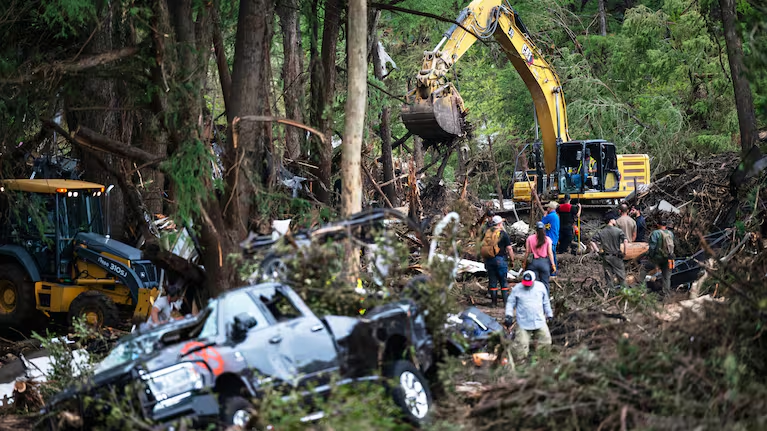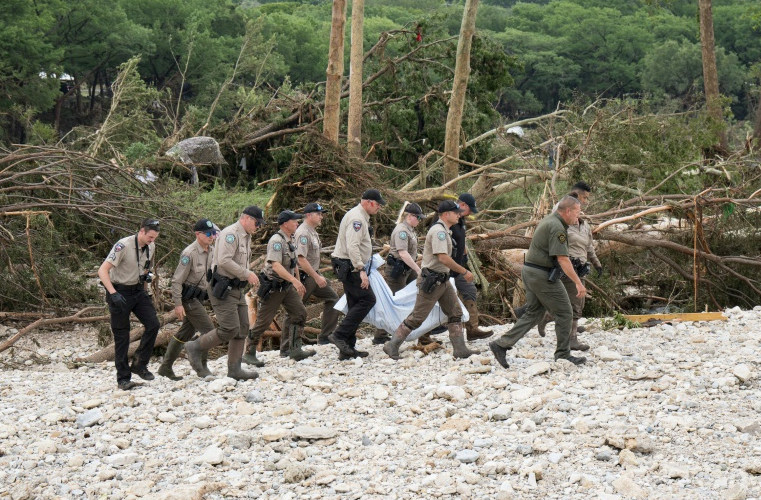120 Lives Lost: Intense Scrutiny on Texas Flood Response Raises Alarming Questions
120 lives lost: intense scrutiny on Texas flood response raises alarming questions about the state’s crisis preparedness and emergency management systems.
Mounting Scrutiny Over Texas Flood Response as Death Toll Reaches 120
Texas authorities are facing intensifying scrutiny over their response to the devastating flash floods that have claimed at least 120 lives, primarily during the Fourth of July holiday weekend. The central Texas Hill Country, known for its scenic rivers and summer camps, became the epicenter of a catastrophic disaster that left communities in mourning and exposed serious gaps in emergency response mechanisms.
The confirmed death toll stood at 120 as of Thursday, after being revised down by one from the previous day. However, over 170 individuals remain missing, with the search entering its seventh day. The disaster has prompted widespread concern, not only due to the scale of the human loss but also due to apparent lapses in early warning communications and crisis coordination.
In Kerr County and surrounding areas, hundreds of emergency workers and volunteers have been combing through thick mud, splintered structures, and vast fields of debris in hopes of locating survivors. But with no live rescues reported throughout the week, hope is fading and fears are mounting that the death toll could climb further in the coming days.
Presidential Visit Amid Crisis
U.S. President Donald Trump, accompanied by First Lady Melania Trump, is expected to visit the flood-affected regions on Friday. The presidential visit has brought heightened attention to the crisis, along with renewed pressure on local and state officials to account for the emergency response timeline, particularly the dissemination of flood alerts.
New questions have arisen over when and how residents were first informed of the danger. At a press briefing on Thursday, Kerrville Police Sergeant Jonathan Lamb deflected a pointed question regarding reports that emergency radios failed to connect between local police and county rescue units during critical moments.
“I don’t have any information to that point,” Lamb responded when asked whether communication failures hampered rescue efforts during the peak of the flood.
Despite this, Lamb expressed gratitude for the widespread volunteer response, noting that many individuals had arrived with boats, off-road vehicles, and earth-moving equipment to aid the search. However, he emphasized that the operation now requires trained professionals to ensure safety and efficiency.
“I don’t want to say it’s been a problem, because we’re so grateful for the amount of people who want to come to this community to help,” Lamb said. “But it’s important that we have certified professional search teams out there right now.”
Delayed Alerts and Communication Failures
One of the most controversial elements of the disaster response revolves around potential delays in issuing flood warnings. According to a report by ABC News, at 4:22 a.m. on July 4, a firefighter in Ingram, a town upstream of Kerrville, contacted the Kerr County Sheriff’s Office requesting an alert be sent to residents in Hunt, a community in the projected path of the floodwaters.
The firefighter’s recorded dispatch call obtained by ABC affiliate KSAT paints a disturbing picture. “The Guadalupe Schumacher sign is underwater on State Highway 39,” the firefighter said. “Is there any way we can send a CodeRED out to our Hunt residents, asking them to find higher ground or stay home?”
The dispatcher’s response was less than reassuring: “Stand by, we have to get that approved with our supervisor.”
According to the report, there was a 90-minute delay before the alert was finally submitted to Kerr County’s CodeRED warning system. In several instances, residents did not receive any warning until after 10:00 a.m. — when the flooding had already swept away dozens of people, including children at summer camps.
Tragedy at Summer Camps
Among the most heartbreaking consequences of the flood was the devastation it brought to summer camps located along the banks of the Guadalupe River. Camp Mystic, a well-known girls’ summer camp, lost 27 young campers and staff. As of Thursday, five additional girls and one counselor remain missing.
Kerr County Sheriff Larry Leitha confirmed that 96 of the 120 deaths were in Kerr County alone. Of those, 36 were children. Kendall County, another affected region, has reported eight fatalities with no change to its total as of Thursday.
The disaster has placed a harsh spotlight on the vulnerability of the region, colloquially known as “Flash Flood Alley” for its propensity to experience sudden and severe flooding. With riverbanks lined with campsites and tourist spots, the impact of an unanticipated natural event can be catastrophic without swift and effective emergency response protocols.
Accountability and Future Measures
As public pressure mounts, reporters have begun questioning whether federal funding cuts to emergency infrastructure may have played a role in the system failures. Sheriff Leitha addressed reporters on Wednesday, stating, “There’s going to be an after-action review. Those questions need to be answered.”
While he admitted being notified of the situation between 4:00 and 5:00 a.m., he did not address specifics regarding how quickly alerts were sent or if earlier warnings could have mitigated the loss of life.
Texas Governor Greg Abbott has called a special session of the state legislature set to begin on July 21. According to Sergeant Lamb, one of the session’s primary agendas will be a comprehensive evaluation of the state’s early warning and emergency response systems.
“This session will be a starting point,” Lamb said. “We must learn from this and ensure we’re better prepared in the future.”
Survivor Accounts, Federal Response, and Calls for Systemic Reform
Survivor Testimonies Paint a Grim Picture
Among the survivors of the Texas flood are families and individuals who narrowly escaped with their lives. Many described the horror of being awakened by sirens or, in some cases, the sound of rising water against their doors. Parents at Camp Mystic recalled frantic moments of trying to reach their children as the riverbanks gave way.
One survivor, 14-year-old Elise Thomas, recounted her story to local media. “We woke up in the dark, and everything was floating. Our bunks, our shoes, even the big logs from outside were inside our cabin. I thought I would die.”
Federal Aid and FEMA Deployment
The Federal Emergency Management Agency (FEMA) has been deployed to assist in the disaster recovery process. FEMA Administrator Deanne Criswell confirmed that search and rescue teams, along with damage assessment specialists, were working alongside local authorities.
“This is a multi-agency operation, and we’re coordinating closely with Texas state emergency management,” Criswell said. She also noted that shelters have been set up across Kerr and Kendall counties to support displaced families.
However, questions remain over the timeliness of the federal response. Critics argue that despite advance weather warnings from the National Weather Service, pre-positioning of federal assets did not occur quickly enough.
Volunteer Overwhelm and Coordination Issues
While volunteers from across Texas have flooded into the area with boats, drones, and supplies, the sheer volume of uncoordinated support has created logistical issues.
“We’ve had to turn people away,” said Kendall County’s Emergency Management Director. “Without central coordination, untrained volunteers risk becoming victims themselves.”

Technical Analysis: Communication System Failures
Preliminary investigations suggest that local communication systems, including emergency radio frequencies and alert networks like CodeRED, were not functioning in full capacity during the initial flood onset. Analysts believe inter-agency coordination software and standardized communication protocols were either lacking or outdated.
Experts from the University of Texas at Austin have proposed that modernizing these systems and introducing AI-based prediction models could significantly reduce the risk in future events.
Infrastructure Gaps and Flash Flood Alley Risks
Texas Hill Country’s topography — with steep hills, narrow river valleys, and low-water crossings — makes it particularly susceptible to flash flooding. Yet repeated warnings from hydrologists over the past decade have gone largely unaddressed.
The 2015 Memorial Day floods and the 2018 Llano River flood were precursors to this current tragedy. In both cases, investigations recommended the reinforcement of riverbanks, improved evacuation protocols, and better emergency drills at campgrounds.
Looking Ahead: What Needs to Change?
In the wake of the disaster, legislators, scientists, and community leaders are calling for a complete overhaul of Texas’s flood risk management system. Proposals include:
- A statewide audit of emergency alert systems
- Investment in predictive flood modeling
- Mandatory certification for summer camp disaster readiness
- Federal-state integrated communication systems
- Increased funding for rural emergency infrastructure
As Governor Abbott’s special legislative session approaches, the urgency for action could not be greater. For the families mourning loved ones, and for the hundreds of volunteers still digging through wreckage, only decisive and systemic reform can prevent another tragedy of this scale.
Political Fallout, Funding Battles, and Environmental Impact
Political Fallout and Escalating Criticism
In the aftermath of the Texas flood catastrophe, the political fallout has been swift and intense. Leaders at both the state and federal levels are facing growing criticism over systemic failures in early warning systems, response coordination, and disaster preparedness. Governor Greg Abbott has come under fire for what many see as reactive, rather than proactive, governance in a region long known for its flood risks.
Congressional Democrats have pointed to decades of underfunding in emergency infrastructure, while some Republicans have argued that local and county-level agencies bear primary responsibility. The bipartisan tension is now set to unfold in upcoming legislative sessions, with mounting calls for independent investigations and bipartisan oversight committees.
President Trump’s visit, while intended to show solidarity, was met with mixed reactions. Protesters gathered outside the Kerrville Town Hall during his tour, holding placards that read “120 Lives Too Late” and “Where Were the Warnings?”
Comparing Past Disasters: Lessons Unlearned
The current crisis has drawn immediate comparisons to past Texas flooding events, including:
- The 2015 Memorial Day Floods, which left 27 dead in Central Texas.
- The 2017 Hurricane Harvey Disaster, where over 100 people died and property damage exceeded $125 billion.
- The 2018 Llano River Flood, which forced mass evacuations and destroyed critical bridges and highways.
In each case, investigations produced exhaustive lists of recommendations. Yet many of those findings were never implemented. A 2016 report by the Texas Division of Emergency Management specifically warned of communication bottlenecks in Hill Country counties, urging digital alert modernization — the same weakness exposed in this latest disaster.
Federal vs State Funding Battles
At the core of the response failure lies a chronic funding tug-of-war. FEMA officials have reportedly clashed with Texas lawmakers over delayed infrastructure requests and emergency management grants. Internal memos leaked this week suggest that proposed FEMA allocations to Texas for alert system upgrades were slashed by over 30% in the last fiscal year.
Meanwhile, Texas legislators have been reluctant to expand budget lines for rural emergency services, prioritizing urban infrastructure instead. Critics argue that this neglect has rendered rural counties like Kerr and Kendall dangerously unprepared.
Environmental Fallout: Long-Term Risks
Ecologists have also sounded the alarm over the environmental damage inflicted by the floods. With oil storage tanks ruptured, untreated sewage discharged into the Guadalupe River, and thousands of gallons of agricultural runoff contaminating water supplies, the long-term consequences are severe.
Texas Parks and Wildlife officials have closed several state parks, citing unsafe water conditions and damage to biodiversity. Endangered species in the Hill Country region — including the Guadalupe bass and golden-cheeked warbler — may have been critically affected.
Environmental advocacy groups have criticized the absence of climate-adaptive land management policies, pointing to increased urban sprawl, deforestation, and impermeable surfaces as key contributors to flash flooding.
Insurance Woes and Economic Shock
Many flood victims now face a secondary disaster: financial ruin. With large portions of the Hill Country outside FEMA flood zone maps, residents lacked flood insurance. The Texas Department of Insurance has received over 28,000 complaints about claim denials or delays.
Local businesses, including tourism-dependent summer camps, ranches, and motels, have reported catastrophic losses. Economists at the University of Houston estimate that total economic damages may exceed $5 billion.
A coalition of local chambers of commerce has appealed for state-backed low-interest loans and immediate FEMA disbursements to prevent widespread bankruptcy in affected areas.

Psychological Toll and Community Trauma
Mental health professionals warn of a looming psychological crisis. “We’re looking at a mass trauma event,” said Dr. Sandra Velasquez, a trauma psychologist working with displaced families.
Children rescued from camps are exhibiting signs of PTSD, while parents and first responders struggle with survivor’s guilt. The Texas Health and Human Services Commission has deployed crisis counseling teams but admits it lacks the resources to meet the scale of need.
Faith-based groups and local nonprofits have opened community centers for grieving and counseling, yet many residents remain in shock, unsure where to begin rebuilding their lives.
Recommendations from Other States
Policy experts are now pointing to successful flood mitigation frameworks from other states:
- Louisiana implemented post-Katrina digital alert systems linked with mobile GPS for targeted evacuation.
- Colorado established inter-agency emergency command protocols after the 2013 floods.
- California mandates annual emergency drills in all youth camps and flood-prone communities.
In light of these examples, pressure is mounting on the Texas legislature to adopt sweeping reforms. Proposals include:
- Mandatory flood drills in all residential summer camps
- Real-time inter-agency communication protocols
- Comprehensive floodplain remapping and zoning restrictions
- Expanded state disaster relief trust funds
Governor Abbott’s July 21 special session is expected to be one of the most closely watched legislative events in Texas history.
Media Coverage, Legal Fallout, and the Future of Emergency Preparedness
Media Accountability and Ethical Coverage
As national media networks continue to broadcast the devastation in Texas Hill Country, questions are being raised about the ethics of disaster journalism. While some outlets have provided life-saving updates and detailed investigative reports, others have been accused of sensationalizing the tragedy, interviewing grieving families during funerals, and showing graphic images without consent.
The Society of Professional Journalists (SPJ) issued a statement urging reporters to prioritize compassion and accuracy. “Disaster coverage must always center on dignity and truth,” the statement read. Media watchdog groups are now calling for newsrooms to follow stricter ethical guidelines, especially in the coverage of minors and survivors experiencing trauma.
Social media platforms also played a dual role. While tools like X (formerly Twitter) and Meta’s Threads allowed rapid information-sharing and on-the-ground updates, they were also flooded with misinformation and fake rescue campaigns. Several unverified posts caused panic, prompting local police to issue alerts distinguishing between official updates and false reports.
Rebuilding Texas Hill Country
With the floodwaters receding, attention has turned toward rebuilding. State and local agencies face the herculean task of restoring roads, power grids, and community infrastructure.
Kerrville and Ingram city councils have announced phased reconstruction plans, beginning with critical services like bridges, sewage lines, and health clinics. Contractors are being brought in from across Texas and neighboring states, while the Texas Department of Transportation (TxDOT) has allocated emergency funds to fast-track road repairs.
However, rural areas remain under-served. Smaller towns like Hunt, Camp Verde, and Center Point have reported limited access to clean water, power, and telecommunications. Community leaders are calling for equitable resource distribution.
Legal Action and Class-Action Lawsuits
Law firms representing dozens of families have begun filing class-action lawsuits against Kerr County, alleging gross negligence in the failure to issue timely flood warnings. At the heart of these legal challenges is the alleged 90-minute delay between first responders’ alerts and the activation of the CodeRED system.
Civil rights organizations have also stepped in, examining whether rural and low-income communities received disparate levels of protection compared to more affluent neighborhoods. Legal experts predict that these lawsuits could set new precedents in disaster accountability jurisprudence.
Some lawsuits target tech vendors contracted to maintain the emergency communications network. One vendor, HillCom Systems, is under investigation for system failures that may have delayed alerts due to software bugs or insufficient server bandwidth.
The Role of Tech in Future Emergency Systems
The disaster has sparked interest from private tech companies looking to offer next-generation emergency solutions. Google has reportedly offered to integrate its SOS Alerts with Texas’s disaster response systems. Similarly, Elon Musk’s SpaceX is exploring Starlink-based emergency satellite communication for use in rural areas without cellular coverage.
Startups and AI labs are also prototyping machine learning systems that could analyze weather patterns, water levels, and real-time sensor data to trigger automatic evacuation alerts.
Critics warn that reliance on private tech comes with privacy risks and profit motives. Nevertheless, emergency managers agree that the integration of public and private systems must be explored.
Climate Resilience: A Long-Term Vision
Experts agree that without climate adaptation strategies, disasters like the Texas flood will become more frequent and deadly. The Hill Country’s susceptibility to flash floods has worsened due to rising temperatures, prolonged droughts followed by heavy rains, and unchecked urban development.
Proposed solutions include:
- Green infrastructure (permeable pavements, rain gardens, wetland restoration)
- Smart levee systems with real-time flood modeling
- Mandatory flood insurance in high-risk zones
- Community-led disaster risk reduction programs
The Texas Commission on Environmental Quality (TCEQ) and universities across the state have begun working on a long-term resilience roadmap. Regional roundtables have been announced to incorporate indigenous knowledge, agricultural concerns, and grassroots community input.
As the rebuilding begins and lawsuits unfold, the legacy of this disaster will hinge not only on how Texas recovers, but on how it prepares for the next inevitable threat.
Interfaith Relief, Survivor Advocacy, and Global Attention to U.S. Disaster Preparedness
Interfaith Coalitions Step In
In the absence of immediate infrastructure recovery in some regions, faith-based organizations have emerged as essential lifelines. An interfaith coalition of churches, mosques, synagogues, and temples has mobilized across Kerr and Kendall Counties to provide food, shelter, clothing, and psychological support to flood survivors.
The Hill Country Interfaith Relief Network, formed within 48 hours of the disaster, has served over 20,000 meals and arranged temporary housing for more than 3,000 displaced individuals. Reverend Lisa Matthews of St. Mark’s Church in Kerrville described the coalition as “a moral necessity in the face of institutional collapse.”
Volunteer counselors trained in trauma response have been deployed by Catholic Charities, the Islamic Circle of North America, and Chabad Disaster Relief. The United Sikhs organization also established a mobile medical clinic in Hunt.
Survivor-Led Advocacy and Grassroots Mobilization
Survivors of the flood are now becoming leaders in the call for reform. Parents of children lost at Camp Mystic have formed a group called “Voices of the River,” demanding legislative action, improved camp safety standards, and a national alert reform law.
Town halls hosted by survivors have drawn hundreds of residents across rural Texas, building momentum for a movement that challenges the traditional top-down disaster policy approach. Among their demands:
- Community representation on state emergency planning committees
- Legal protections for whistleblowers reporting safety failures
- Statewide annual drills for natural disasters
Their efforts have gained national attention, with several members invited to testify before the Texas legislature during the upcoming special session.
Education Crisis: Disruption and Displacement
The flooding has severely impacted local education systems. Nearly 40 schools across five counties have been damaged or rendered inaccessible. With over 12,000 students displaced, Texas Education Agency (TEA) officials are working on emergency relocation plans.
Temporary classrooms are being erected in neighboring towns. However, concerns about transportation, digital learning access, and mental health resources remain unresolved. School counselors report a dramatic rise in anxiety and depression among affected students.
TEA Commissioner Mike Morath stated that additional funding is being allocated for school-based trauma counseling and mobile classrooms, but education unions say long-term investment will be essential for full recovery.

Navigating Federal-State Tensions
Coordination between federal and state authorities has seen both collaboration and conflict. FEMA and the Texas Division of Emergency Management (TDEM) continue to clash over data transparency and funding allocation.
While FEMA insists on federal oversight of distributed aid, state officials argue for more localized discretion. Disputes have delayed the disbursement of critical resources, including emergency housing vouchers and mobile health units.
In response, the White House has appointed a special liaison to Texas to improve real-time coordination. The Department of Homeland Security is also exploring legislative pathways to streamline disaster authority hierarchies during future crises.
Global Attention and Lessons for the World
International media and disaster agencies are closely monitoring the Texas response. The United Nations Office for Disaster Risk Reduction (UNDRR) issued a statement expressing concern over the failure of early alert systems in one of the world’s most technologically advanced nations.
The European Union’s Civil Protection Mechanism has offered expert advisors to assist with future risk planning. Disaster response agencies in countries like Japan, the Netherlands, and Bangladesh have cited the Texas floods as case studies for their own infrastructure reviews.
Meanwhile, climate advocacy groups around the world are calling for increased U.S. commitment to international climate resilience funding, pointing to the Texas tragedy as a warning of global climate vulnerability.
A National Reckoning
The Texas flood of July 2025 may come to represent more than a regional natural disaster. It could mark a turning point in how the U.S. prepares for, responds to, and recovers from environmental catastrophes.
From faith communities and grieving families to local educators and international experts, the demand for systemic change is now unified and urgent. As Governor Abbott’s special legislative session approaches and lawsuits proceed through the courts, the outcome will determine not just the legacy of this tragedy — but the future resilience of a state increasingly threatened by climate extremes.
Also Read : Indian Tennis Player Radhika Yadav Shot Dead by Her Father in Shocking Incident








